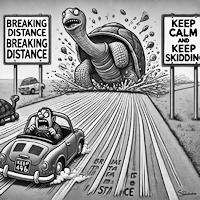Deceleration Distance Calculator

The Deceleration Distance Calculator determines the distance required for an object to decelerate from a given initial velocity to a final velocity at a specified deceleration rate. This tool is essential for vehicle stopping analysis, safety studies, or general physics applications. The calculator outputs the stopping distance in both metres and feet, providing precise results for diverse scenarios.
Deceleration Distance Calculator
Calculator
- enter the initial velocity of the object and select the velocity unit you want to use in your calculation
- the final velocity of the object, and the calculation unit
- the rate at which the object slows down in your chosen unit
- decimal precision, the number of digits after the decimal point
Results
- the stopping distance in metres
- the stopping distance in feet
Formula:
The stopping distance is calculated using the formula:
\[ s = \frac{v_0^2 - v^2}{2a} \]
Where:
- \(s\): Stopping distance (m or ft)
- \(v_0\): Initial velocity (m/s, ft/s, km/h, mph)
- \(v\): Final velocity (m/s, ft/s, km/h, mph)
- \(a\): Deceleration rate (m/s², ft/s²)
Example Calculation:
Scenario: A car decelerates from an initial velocity of \(90 \, \text{km/h}\) to a final velocity of \(36 \, \text{km/h}\), with a deceleration rate of \(3 \, \text{m/s²}\). What is the stopping distance?
Step 1: Convert velocities to metres per second:
\[ v_0 = 90 \, \text{km/h} \div 3.6 = 25 \, \text{m/s} \] \[ v = 36 \, \text{km/h} \div 3.6 = 10 \, \text{m/s} \]
Step 2: Apply the formula:
\[ s = \frac{v_0^2 - v^2}{2a} = \frac{25^2 - 10^2}{2 \cdot 3} = \frac{625 - 100}{6} = \frac{525}{6} = 87.5 \, \text{m} \]
Step 3: Convert the result to feet:
\[ s = 87.5 \, \text{m} \times \frac{1 \, \text{ft}}{0.3048 \, \text{m}} = 287.07 \, \text{ft} \]
Result:
- Stopping distance in metres: \(87.5 \, \text{m}\)
- Stopping distance in feet: \(287.07 \, \text{ft}\)